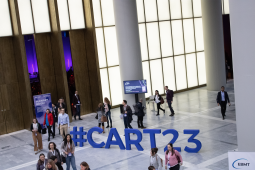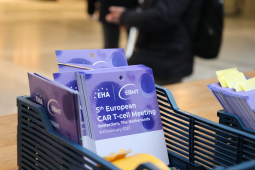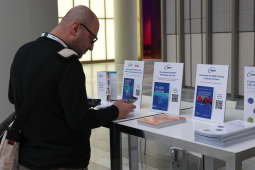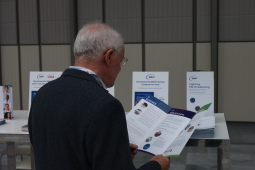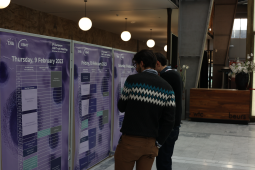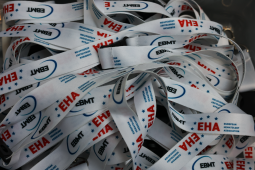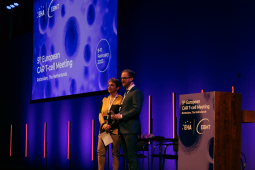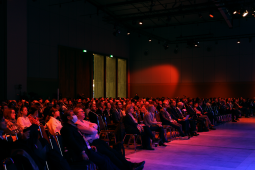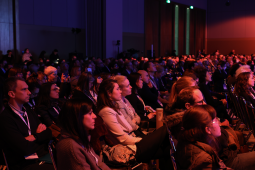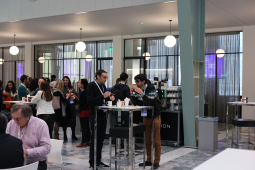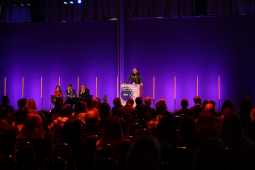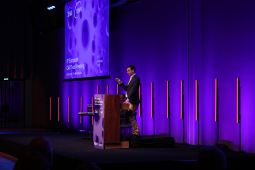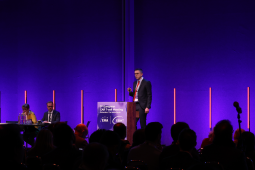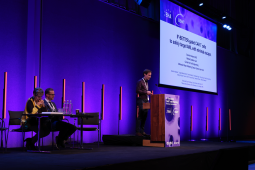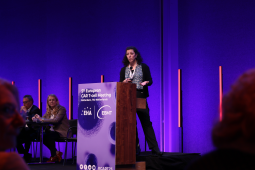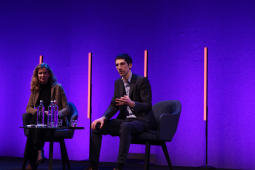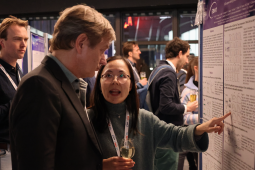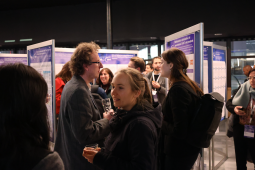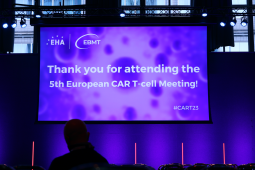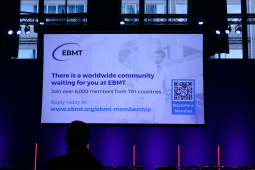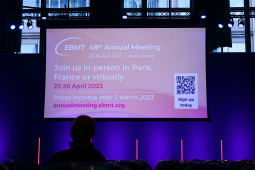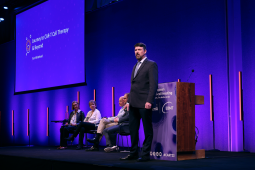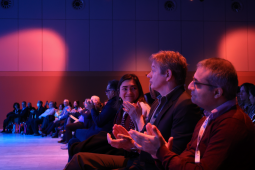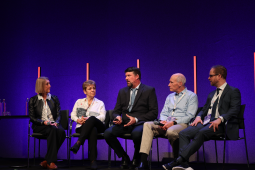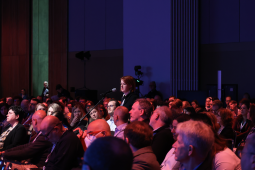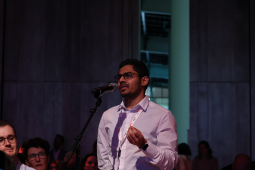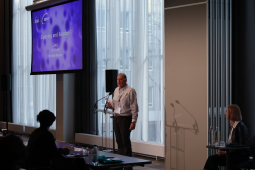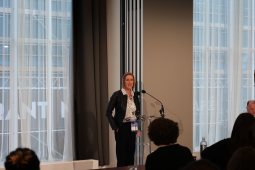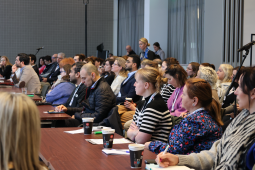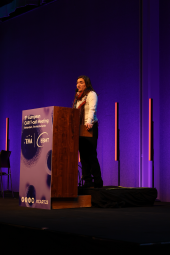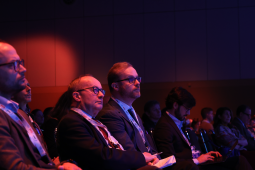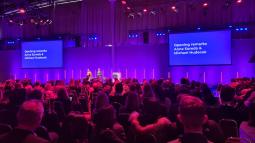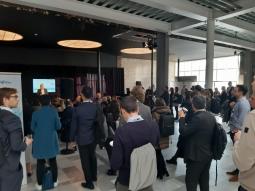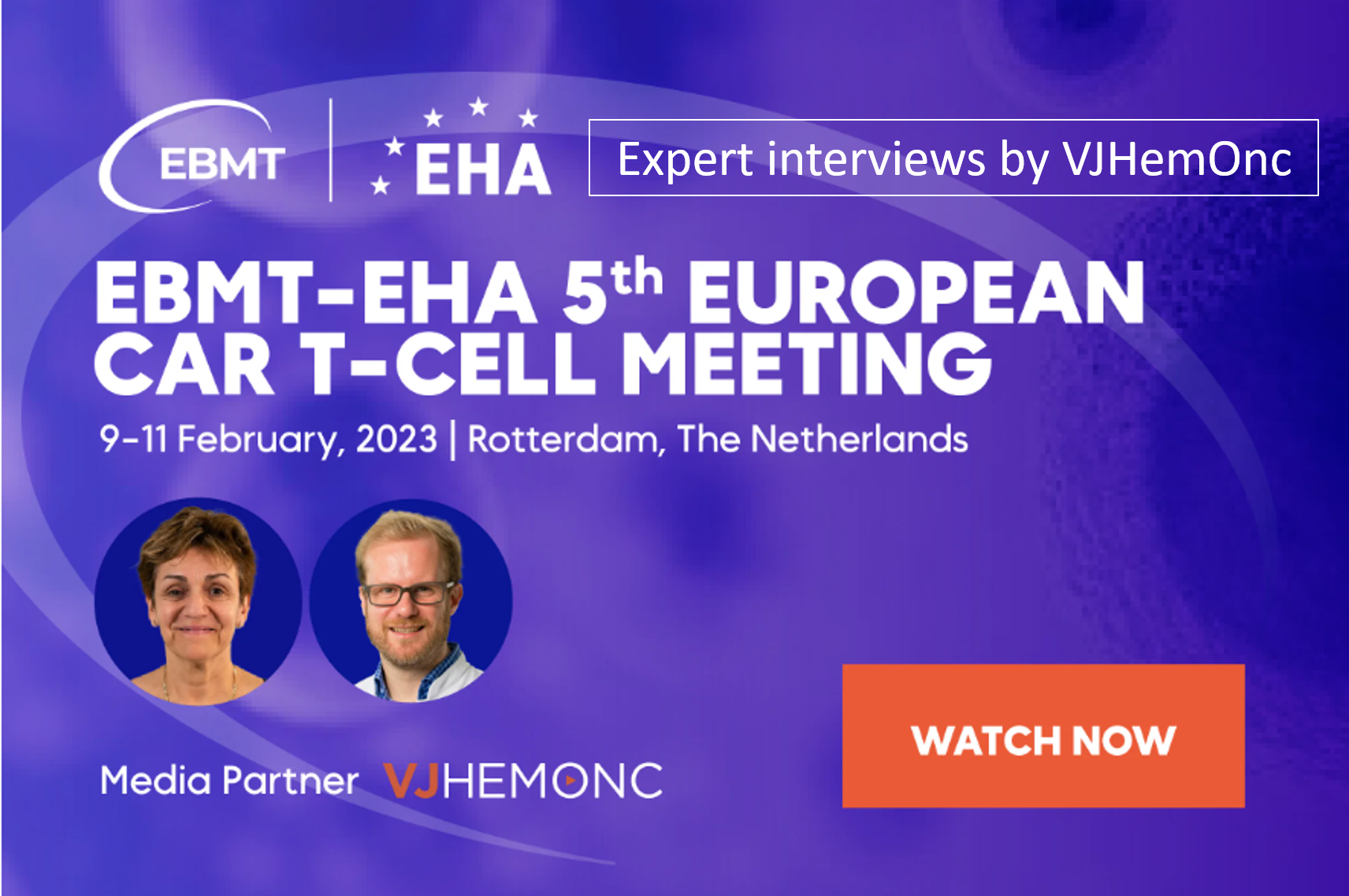The 5th European CAR T-cell Meeting was jointly organised by the EBMT and the EHA. 800 delegates got the chance to meet again physically in Rotterdam after the 2020 edition in Sitges, Spain and two virtual editions. The meeting was also attended virtually by 500 attendees.
The meeting was a real celebration; a celebration of science and innovation, a celebration of patient care and advocacy and an opportunity to meet once again in person for practice sharing and real networking.
Below, you can read the summaries of the sessions.
Physicians' sessions
Keynote Lecture - Bringing CAR T to the next generation for efficacy and safety - Maria Themeli
Chairs: Alejandro Madrigal (UK) & Alina Daniela Tanase (RO)
Bringing CAR T to the next generation for efficacy and safety Maria Themeli (NL)
Summary by Almudena Navarro Bailon, Hospital Universitario de Salamanca, Spain
In this keynote talk, Prof. Maria Themeli, presented nicely the results of their research on the improvement of CAR T cell efficacy. Two of the main known causes of CAR T cell therapy failure are antigen negative relapse and the lack of persistence of CAR-T cells. OR gates have been proposed as an approach to overcome antigen negative relapse, either using two separate receptors to target two different tumor antigens, or using a tandem receptor. In prior works, Themeli’s group showed that combining a second generation CD28 CAR with the coexpression of a 4-1BB costimulatory ligand can regulate the tonic signalling of CD28 domain and lead to improved persistence.
Prof. Themeli’s lab has evaluated an elegant approach merging the advantages of double targeting of tumor antigens and the coexpression of costimulatory molecules using a Chimeric Costimulatory Receptor (CCR), which does not mediate specific killing, but provides an extra costimulatory signal. By combining a BCMA CAR construct and a CCR targeting CD38, they show increased binding avidity and improved CAR-T cell function using first, second and third generation constructs, and across different level of expression of BCMA. Interestingly, this effect is even seen when CD38 antigen is provided by other healthy cells and not expressed on the tumor cells, leaving intact the healthy accessory cells, which makes this approach very attractive for targeting tumor microenvironment cells.
In a second step, they have improved the design of the platform by using a high affinity ScFv domain and transforming the CCR into an inducible component dependent on the activation of the CAR receptor, using a novel induction system (non transcriptionally regulated).
Keynote Lecture – Journey to CAR-T Cell Therapy & Beyond, Emily Whitehead's Story - Tom Whitehead
Chair: Michelle Kenyon (UK) & Michael Hudecek (DE) & Anna Sureda (ES) & Carl June (US)
Journey to CAR-T Cell Therapy & Beyond, Emily Whitehead's Story Tom Whitehead (US)
Summary by Eleni Gavriilaki, Aristotle University of Thessaloniki, Greece
The 2nd day started with an inspiring and emotional keynote lecture, a story told by Tom Whitehead. One could call him the "father" of CART cell therapy patients.
He shared the story of Emily's and her parents' journey over the last decade, with a unique balance of emotional and professional elements. A key element in the difficult days seemed to be optimism. He also emphasized on how Emily wants to be seen as a normal teenager but also wants to help other families. More than that, he highlighted the enormous work of their foundation on supporting children, adolescents and adults in need of CART cell therapy.
This story led to an in-depth philosophical discussion with the audience and the "father" of CART cell therapy, Dr Carl June. The latter introduced the notion that we now have 3 cellular therapies: blood transfusion introduced 100 years earlier, hematopoietic cell transplantation almost 30 years earlier and CART cell therapy over the last 10 years. Last but not least, questions on worldwide accessibility were raised paving the way into democratizing CART cell therapy.
Keynote Lecture - Mechanisms driving CAR T cells - Marcela Maus
Chairs: Chiara Bonini (IT) & Dirk Busch (DE)
Mechanisms driving CAR T cells Marcela Maus (US)
Summary by Alba Rodriguez-Garcia PhD., postdoctoral fellow, IDIBAPS-Clinic Foundation, Barcelona, Spain
On her keynote lecture, Dr. Marcela Maus focused on mechanisms driving efficacy and toxicity of CAR-T cell therapies in both liquid and solid tumors, and touched on opportunities to increase potency while mitigating adverse effects.
In a first approach aimed at understanding mechanisms accounting for therapy success or failure, single-cell transcriptomic studies were performed on samples from large B cell lymphoma patients treated with tisa-cel (CD19-4-1BBz CAR) or axi-cel (CD19-CD28z CAR) that were stratified by responders and non-responders. These studies revealed that CD8+CAR+ T cell expansion 7 days post-treatment was predictive of prolonged responses in patients treated with 4-1BB but not CD28 co-stimulated CARs. In this same study, the presence of regulatory T cells transduced with CARs in the pre-infusion product was identified as one of the mechanisms driving resistance to axi-cel therapy, but also seemed to be relevant in 4-1BB co-stimulated CAR-T cells as demonstrated in a preclinical mouse model1.
The second approach she commented on was aimed at identifying mechanisms driving tumor cell resistance to CAR-T cell mediated killing. Following a genome-wide CRISPR knockout screen on a glioblastoma tumor cell line, loss of genes from the IFNγ pathway (e.g. IFNγR1) rendered tumor cells resistant to CAR-T cell cytotoxicity. This effect could be compensated through the overexpression of the intercellular adhesion molecule ICAM-1, which increased the avidity of CAR-T cell and tumor cell binding, stressing the importance of enhancing binding interactions. This mechanism was relevant in solid but not in liquid tumors, revealing a differential mechanism of resistance between the two settings2. Elaborating more on the role of the IFNγ pathway in CAR-T cell therapies, Dr. Maus showed that this pathway is not required for antitumor efficacy in the setting of hematologic malignancies, providing an opportunity for the use of IFNγ KO CAR-T cells that would reduce cytokine-related toxicities while maintaining antitumor effect3.
References:
1. Haradhvala NJ, Leick MB, Maurer K, Maus MV, et al. Distinct cellular dynamics associated with response to CAR-T therapy for refractory B cell lymphoma. Nat Med. 2022 Sep;28(9):1848-1859. doi: 10.1038/s41591-022-01959-0.
2. Larson RC, Kann MC, Bailey SR, Maus MV, et al. CAR T cell killing requires the IFNγR pathway in solid but not liquid tumours. Nature. 2022 Apr;604(7906):563-570. doi: 10.1038/s41586-022-04585-5.
3. Bailey SR, Vatsa S, Larson RC, Maus MV, et al. Blockade or Deletion of IFNγ Reduces Macrophage Activation without Compromising CAR T-cell Function in Hematologic Malignancies. Blood Cancer Discov. 2022 Mar 1;3(2):136-153. doi: 10.1158/2643-3230.BCD-21-0181.
Keynote Lecture - Antigen sensitivity, persistence and gated control of CAR T cells - Michel Sadelain
Chairs: Anna Sureda (ES) & Michael Hudecek (DE)
Antigen sensitivity, persistence and gated control of CAR T cells Michel Sadelain (US)
Summary by Nico Gagelmann: University Medical Center Hamburg-Eppendorf, Germany
Prof Sadelain from MSKCC in his keynote highlighted the necessity to improve CAR-T designs to overcome currently observed toxicities and resistances. One key feature is antigen density required for cytolysis which is best for a heterogeneic receptor (HIT) and lowest for a 4-1BB design, while the CD28 design is somehow in the middle. In addition, Cryp-EM can inform affinity and sensitivity determination of the CAR. Also, IF-BETTER gate designs combine effectively 2 targets, while an OR-gate shows significantly higher sensitivity.
Session 1: Clinical Indications I – Lymphomas
Chair: Marie Jose Kersten (NL) & Catherine Thieblemont (FR)
Large B Cell Lymphoma (LBCL) Anna Sureda (ES)
Mantle Cell Lymphoma (MCL) / Follicular Lymphoma (FL) Ulrich Jaeger (AT)
Resistance Marco Ruella (US)
The role of the intestinal microbiome in cancer immunotherapy Marcel Van den Brink (US)
Summary by Ulrich Jäger, Professor of Haematology, Medical University of Vienna, Austria
In this opening clinical session data on the latest clinical developments in lymphomas were presented.
Anna Sureda reviewed the current data and treatment standards in large B-cell lymphoma (LBL). Patients with relapsed or refractory LBL have a dismal prognosis with conventional therapies. CAR-T cells have improved PFS and overall survival when applied in 3rd line. This has now extensively been confirmed by real world experience. There are now data from more than 3000 patients in the RBMT registry captured. CAR-T cells have also outperformed SOC including autologous stem cell transplantation in patients with refractory or early relapsing LBL after first line therapy (ZUMA-7, TRANSFORM). This has resulted in a steady decline in the number of autologous transplants since 2020. The LYSA ALICANTE trial has also confirmed the efficacy of CAR-T cells in 2nd line treatment for non-transplant eligible patients. Further improvements will be based on a better understanding of prognostic factors for better patient selection including type of previous therapies, bridging and salvage strategies with novel agents.
Ulrich Jäger reviewed the efficacy of CAR-T cells in mantle cell lymphoma and follicular lymphoma (G1-3A). In MCL, brexucabtagene autoleucel has been approved by the EMA after > treatments including a BTK inhibitor. High response rates (80-90%) and PFS rates (52.9% after 24 months) were also confirmed by the first real world data as well as with 2 other products (lisocabtagene maraleucel and tisagen lecleucel) in smaller series. CAR-T s are effective across all risk groups. In relapsed or refractory follicular lymphoma, 2 products (axicabtagene ciloleucel and tisagen lecleucel) have been approved. Both underlying trials (ZUMA-5 and ELARA) had high response rates over 80% and a PFS of 54 or 57%, respectively. Toxicity was low and CAR-Ts have shown efficacy in all subgroups, including POD24 patients. For both, r/r MCL and FL CAR-T cells represent a new standard. However, with the advent of other effective strategies including bispecific antibodies, decision making in individual patients will include more choices. On the other hand, the landscape of treatments changes constantly making the generation of guidelines difficult. The most burning questions for both diseases are the the possible replacement of autologous stem cell transplantation, sequencing and combination strategies.
Marco Ruella presented mechanisms of resistance and showed interesting data for LBL. A considerable percentage of DLBCLs lose their target antigens upon relapse (CD19, but also CD20). This knowledge influences strategies for targeting. In the second part Dr. Ruella focused on apotosis as a mechanism involved in resistance. He presented exiting data using BCL2 inhibitors and the introduction of BCL2 mutations into CAR-T cells to overcome potential problems. With the increasing number of patients treated and the resulting high numbers of relapses, prevention and treatment of this dismal event will become more important.
Marcel van den Brink reviewed the involvement of the gut microbioma in response and resistance to immunotherapies, focusing on CAR-Ts. Recent data show a better outcome of patients with lymphoma with more diverse or a favorable composition of the gut flora. Antibiotic treatment preceding the CAR-T infusion results in poor outcome. In addition, he presented data where the gut flora early after infusion predicted toxicity.
Overall, the session showed the exciting possibilities with CAR-T cell treatments in lymphoma and the potential improvements based on translational research data.
Session 2: Clinical Indications II - Acute & Chronic Leukaemias
Chairs: Annalisa Ruggeri (IT) & John Gribben (UK) & Stephan Mielke (SE)
Acute Lymphoblastic Leukemia (ALL) André Baruchel (FR)
Novel targets and technologies for CAR-T cells in AML Michael Hudecek (DE)
Chronic Lymphocytic Leukemia (CLL) John Gribben (UK)
T-cell Acute Lymphoblastic leukemia (T-ALL)/Treating
T-Cell Non-Hodgkin Lymphoma (T-NHL) Maksim Mamonkin (US)
Summary by Valentín Ortiz-Maldonado, Department of Hematology, Hospital Clínic de Barcelona, Spain.
The early outcomes achieved with CAR T-cell therapy in B-cell ALL has been the tip of the spear of this technology. The success seen with several CAR T products in this disease has galvanized the development of this therapeutic approach into several other diseases. However, despite the exquisite sensitivity after CAR T-cell therapy observed across several types of products, designs, manufacturing procedures, product formulation, lymphodepleting schemes and patient characteristics (among others), relapsed/refractory B-ALL remains mostly incurable in a considerable proportion of patients. Moreover, the weight of this proportion seems to increase the older the patient gets, with several unanswered questions regarding which is the best formula to reach definitive remission.
In this setting, Dr. André Baruchel walked us through some relevant aspects of CAR T-cell outcomes in B-ALL and how, even when the initial outcomes have proven promising, CAR T-cell therapy might need further runway to consolidate its curative potential as a stand-alone therapy. In fact, the updated outcomes of the ELIANA trial, which ground-breaking outcomes led to the approval of tisagenlecleucel, have shown that patients can still develop late relapses. This means that the plateau previously observed at their initial publication (Maude et al, NEJM 2018) could need further long-term follow-up to be confirmed. On the other hand, the outcomes in adult ALL patients with another CART19 product, AUTO-1, might shed some light into the problem of CART19 persistence. The incorporation of a “low-affinity” CAR binder may lead to an improved modulation of CAR-mediated tonic signalling, potentially leading to a decrease in T-cell exhaustion and increase in functional CAR T-cell persistence. The relatively low proportion of CD19+ relapses in this adult population and the relatively high proportion of long-term duration of B-cell aplasia may back this potential and interesting concept.
Other relevant aspects highlighted by Dr. Baruchel were the impact of the sensitivity to preceding therapy regarding the outcomes to CART19 therapy. First, the increased risk of CART19 failure in patients B-ALL that have previously proven refractory to blinatumomab (another CD19-targeted therapy), but also, the preservation of sensitivity to CART19 therapy in case of previous response to blinatumomab. Secondly, the importance of the sensitivity to other T-cell engaging therapies, like allogeneic stem cell transplantation (allo-HCT). An interesting article published by Bader et al, (Blood Adv 2023) showed how the timing of relapse after allo-HCT seemed to have a clear impact in the efficacy of CART19 therapy, as patients undergoing “early relapses” after allo-HCT (<6m) had a considerable worst EFS, RFS and OS in comparison to those patients treated with CART19 after “late relapses” after allo-HCT (>6m).
Switching lineage into AML, Dr. Michael Hudecek reminded the great lag that still remains in the AML field in comparison to the CD19+ counterpart. However, there is an ever-growing increase in new target options in preclinical and clinical development: CD33, CD123, FLT3, CLL-1, CD44v6, gamma-delta T-cells and IL1RAP, among others. Nevertheless, despite the wide variety of available targets in AML, so far, there are no option that could really emulate the “CD19 paradigm” achieved in B-cell malignancies: almost all targets expressed in AML also are expressed in other vital hematopoietic cells. So, the question is how to specifically target malignant AML cells without affecting considerably other vital and healthy hematopoietic cells. In this regard, an interesting concept arises from two different combinational approaches by revisiting two small molecules previously seen in the vicinity of AML management: FLT3 inhibitors and hypomethylating agents. This interesting aspect have been seen with anti-CD123 CAR T-cells: despite CD123 is expressed in AML blasts it is also expressed on normal hematopoietic cells. However, in preclinical models the coadministration of azacytidine seems to increase the efficacy of CART123 by (1) increasing CAR T-cell fitness, (2) decreasing CAR T-cell exhaustion, and (3) increase of CD123 expression density in AML cells. Similar findings have been seen with the coadministration of several FLT3 inhibitors in anti-FLT3 CAR T-cells, including crenolanib, midostaurin and quizartinib. This coadministration seems to increase the preclinical efficacy of anti-FLT3 CAR T-cell therapy by increasing FLT3 expression density on AML cells.
Going back to B-cell malignancies, Dr. John Gribben reviewed the current status of CAR T-cell development in CLL. In this regard, after the initial reports of relatively suboptimal outcomes achieved with this this approach, widely attributed to the T-cell dysfunction that characterizes CLL, promising outcomes arrive from another combinational approach by again, revisiting some well-known drugs already approved for CLL management: BTK inhibitors. Preclinical and clinical evidence is steadily growing pointing towards a synergistic effect on CAR T-cell efficacy by its combination with ibrutinib and acalabrutinib. As it seems that the immunomodulatory effect of these BTKi may derive in an increase the function of CAR T-cells, not only in T-cells from CLL patients, but also even on healthy donor T-cells. Finally, a quick reminder of the initial outcomes of the TRANSCEND CLL 004 study of the use of lisocabtagene maraleucel on refractory CLL that is showing promising safety and efficacy outcomes. In fact, the ORR of 82% and the deep and durable MRD-negative responses of 65% in the bone marrow could be compared to the ones obtained by other approved CAR T products in other indications.
And finally, Dr. Maksim Mamonkin faced the difficult task of overviewing the current status of CAR T-cell therapy in T-ALL: a different novel where the risk of fratricide, T-cell depletion and the possibility of antigen masking complete a complex immune thriller full of adversities. In this regards, CD5 and CD7 targeted CAR T-cells currently stand out as two great candidates for clinical challenge. Unfortunately, both, CD5 and CD7 are not only expressed in T-ALL cells, but also in most healthy T-cells. So, with the risk of fratricide lurking around the answer might be, yet again, a combinational approach. In this regard, despite CD5-targeted CAR T-cells (which also express CD5) may overcome fratricide by rapidly internalizing CD5 in a CAR-mediated manner, they still are subjected to an intense CD5-driven tonic signalling. This issue may be the responsible for the increased terminal differentiation and limited persistence and efficacy observed with this approach. To solve this issue, the combination use of well-known two inhibitors, ibrutinib (BTKi) and dasatinib (TKI) could be the answer. By muting the intense CAR signalling during CART5 manufacturing, ibrutinib and dasatinib co-culture seems to lead to an enrichment of minimally differentiated CART5 in the final product. Similar outcomes have been seen by using healthy T-cells from stem-cell donors. After these two manoeuvres, 4 of 6 patients treated (67%) have achieved a robust CAR T-cell expansion and, more importantly, a complete remission. On the other hand, CD7-targeted CAR T-cells (CART7) may face a rather different situation: a situation where extensive fratricide takes place. Therefore, CART7 cells don’t easily expand in vitro. This issue can be solved either by selectively knocking out CD7 expression in CAR T-cells, or by using a CD7 expression blocker (PEBL) in preclinical models. However, adding this extra gene-editing step also leads to a considerable increase in complexity for clinical-grade trial approval by regulators. A possible alternative to these extra gene-editing steps is yet again, a combinational approach: the coculture of CART7 cells with ibrutinib and dasatinib prevent fratricide by muting the CAR mediated signalling during CAR T manufacturing. This effectively allows CART7 expansion in a rather comparable way to the one to be obtained with CRISPR-mediated knockout of CD7 in preclinical models. Preclinical models have shown that once the final CART7 product is infused a natural selection and expansion of CD7-negative CART7 cells takes place over time. This leads to long-term persistence of a dominant population of CD7-negative CART7 cells. The question if this approach may be translated to real patients will be answered by the CRIMSON-NE trial, which is currently enrolling patients with refractory T-ALL and T-NHL.
Session 3: Clinical Indications III - Multiple Myeloma
Chair: Ibrahim Yakoub-Agha (FR) & Paula Rodriguez Otero (ES)
Overview Hermann Einsele (DE)
CAR T myeloma; biomarkers, PK, risk factors Ibrahim Yakoub-Agha (FR)
ARIcel in MM/Amyloidosis Carlos Fernandez de Larrea (ES)
Summary by Nico Gagelmann: University Medical Center Hamburg-Eppendorf, Germany
In the first two talks, Prof. Einsele from the University of Würzburg and Prof. Yakoub-Agha from the University of Lille gave an overview of the current landscape of CAR-T cell therapy results in multiple myeloma, mostly the relapsed/refractory setting, presenting published results of the two approved products ide-cel and cilta-cel. He then also showed new developments such as the CC-98633 presented at ASH last year, showing remarkable overall response of 100%, with only 2% severe CRS or ICANS, respectively. Another new approach might be the incorporation of prophylactic tyrosine kinase inhibition with dasatinib during first 5 days after ide-cel infusion to increase CAR-T cell persistence, which has been shown to effective in the lymphoma field. Furthermore, preliminary results for moving CAR-T in earlier lines has been presented, especially showing promising efficacy in KARMMA-2.
In the last talk, Prof. Fernandez de Larrea from Barcelona showed results of the first ever academic CART project in Europe ARI0002h, which was fast and feasible in myeloma. Responses obtained were deep and sustained, with relative low-grade toxicity. Overall response was 100% and complete response 67%. Of note, no neurotoxicity was seen. This is a promising project and should be template for European groups across borders.
Session 7: New Academic Initiatives & CAR-T Therapy Networks
Chairs: Chiara Bonini (IT) & Natacha Bolaños (ES)
GoCART Initiative Jürgen Kuball (NL)
The EBMT Registry: monitoring CAR-T Cells and IECs activities in Europe Christian Chabannon (FR)
IMI EU T2EVOLVE Carmen Sanges (DE)
Advanced Therapies Network Spain Jose M. Moraleda (ES)
CAR-T Switzerland Caroline Arber (CH)
Summary by Natacha Bolaños, Chair EBMT Patient Advocacy Committee, Lymphoma Coalition
This session, as described by the first speaker Jürgen Kuball, was about making the impossible, possible.
GoCART Initiative was introduced as a unique partnership between EHA and EBMT. Dr. Kuball highlighted how EBMT and EHA bring together commercial and academic stakeholders by using JACIE as backbone, and remarked the challenges concerning different accessibility, secondary use of data, regulatory management and toxicity management, among others. Considering the diversity of Europe, GOCART is not meant to break the silos but to build bridges, how can we make consensus, how can we connect long term data to compare practice and outcomes in different countries and settings.
Christian Chabannon (France) presented the CAR-T Data Collection Initiative EBMT Registry, which is monitoring the status of patients registered to be treated with CAR-T therapy in Europe, and aims to further develop studies to evaluate the efficacy and safety of these agents. Dr. Chabannon explained the potential behind the data collected for the different stakeholders and to advance clinical practice to improve patient outcomes, but also remarked the hurdles to implementation of the cellular therapy form as changes in IT platform at the EBMT registry, changes needed in reporting process, implementation of GDPR, an issue for secondary use of data, and the difficulties when working with much higher numbers of stakeholders that the transplant community, managing multiple expectations and facing competing interests.
Carmen Sanges (Germany) provided with an overview of the IMI EU T2EVOLVE ecosystem composed by 29 partners including patient community, academia, clinicians. T2EVOLVE is looking to accelerate early-phase clinical trials, standards analytical methods, CAR-T detection standardization strategy. One of the biggest areas of actions is gaining insights into patients’ experiences, quality of life, and unmet needs through a survey developed byT2EVOLVE and QUALITOP H2020 consortia in close collaboration with patient advocacy groups, patients and carers.- The survey targets adult patients who went through CAR-T therapy in Europe and are willing to share their experiences.
Jose M. Moraleda (Spain) presented the Advanced Therapies Network Spain TERAV, but started recalling how Spain led the ATMPs clinical trials in Europe from 2004 to 2010, fact that had strong influence to map the strategic plan to access ATMPs with a focus on CAR-T cell therapy, currently possible at 30 hospitals authorized to deliver the therapy under a special access scheme part of the basket of services of the national health system. TERAV Network was introduced by Dr. Moraleda as a collaborative and translational project aimed to develop Advanced Therapy Medicinal Products (ATMPs) that can be transferred to society once scientifically validated. Network groups share knowledge and innovations to standardise and extend the manufacture of new ATMPs, facilitate their accessibility and affordability at a sustainable production price. TERAV addresses unmet clinical needs in both children and adults, known as "rare" congenital and acquired diseases, such as monogenic diseases, acute leukaemias and major paediatric malignancies, as well as other of the most prevalent human diseases such as osteoporosis, osteoarthritis, immunohaematological and inflammatory diseases and various types of adult haematological cancers. The Network is made up of 32 research groups, spread across 11 centres in different regions within Spain, of which 17 are clinical-epidemiological teams working in NHS hospitals and 15 are academic scientists. A total of 358 researchers, endorsed by their high quality scientific contribution in the areas of gene therapy, immunotherapy, CAR cells, somatic cell therapy, stem cell and progenitor cell manufacturing, tissue engineering and biotechnology, and with extensive experience in clinical trials with ATMP. In addition, TERAV is supported by 19 Associated Clinical Groups that act as facilitators of the transfer of research in development to clinical practice.
Dr. Caroline Arber (Switzerland) provided an overview of swiss centers active in delivering immune effector cell therapies, their framework for clinical trials with academic cell production and delivery to participating sites. Dr. Arber started by introducing the academic immune effector cell therapy developments in Switzerland. With 1o active cellular therapy centres, Switzerland has two collaborative networks. The first is the Swiss Blood Stem Cell Transplant and Cellular Therapy SBST, representing all Swiss centers performing cellular therapies (nationally and internationally, EBMT/JACIE /CIBMTR since 1998. The network holds the national cell therapy registry and the donor registry. The second network is the Swiss working group for cancer SAKK, primary partner and competence center in clinical cancer research for stakeholders including authorities, associations and pharmaceutical companies in Switzerland. SAKK established the Cellular Therapy Working Group in 2019 to coordinates the platform for cell therapy throughout Switzerland, and to advance T-cell therapy innovation and clinical research. SAKK supports the development of multicenter interventional studies, real world database across disease entities supporting observational research projects, and provides the platform to coordinate international research collaborations.
Dr. Arber presented the 900m2 cell manufacturing facility at CHUV/UNIL/Ludwig Lausanne, explained how research proposals are selected and implemented within the SAKK network and provided highlights on their completed and ongoing studies on adoptive transfer of expanded NK cells, virus-specific Tcells (VSTs) for infections or EBV + post-transplant lymphoproliferative disease (PTLD), tumour infiltrating lymphocites (TILs) fore melanoma and solid tumours, and CAR-T cell therapy for hematologic malignancies.
Session 8: Clinical Management of CAR-T Patients
Chair: Arnon Nagler (IL) & Valentin Ortiz-Maldonado (ES)
Patient perspective: CAR-T Journey Kenneth Casler (FR)
Car-HLH: A devastating complication following Chimeric Antigen Receptor T-cell (CAR-T cell) therapy Muhammad Gohar Maqbool(UK)
Case presentation discussion: adult lymphoma
Panellists: Peter Dreger (DE) & Paolo Corradini (IT)
Successful Treatment of Romiplostim for Persistent Thrombocytopenia Following CAR-T Cell Therapy in Phi+ B-ALL: A Case Report Julien Dereme (CH)
Case presentation discussion: adult ALL
Panellists: Mohamad Mohty (FR) & Claire Roddie (UK)
Myositis in a patient with relapsed/refractory multiple myeloma treated with anti-BCMA CAR T-cell therapy Sofía Huerga Domínguez (ES)
Case presentation discussion: Multiple Myeloma
Panellists: Paula Rodriguez Otero (ES) & Michel Delforge (BE)
Summary by Yasmina Serroukh, Erasmus MC Cancer Centre, Erasmus University, Rotterdam, The Netherlands
First, William Kenneth Casler gave a testimony on his CAR-T cell therapy journey from the patient’s perspective. In his case the CAR-T decision came after 13 years of continuous therapy. The waiting time between the decision and the infusion was harsh but yoga practice, meditation, positive mind set and determination helped a lot. The whole process was a roller coaster of challenges, Mister Casler counted 21 different side effects at various degrees of intensity. After recovery, he’s feeling normal again and has many projects for the coming months. Concluding, CAR-T cell therapy has been for him a life-enhancing, quality of life improving and transformative experience.
Muhammad Gohar Maqbool from Bristol UK presented an interesting but unfortunately fatal case of CAR-T cell associated hemophagocytic lymphohistiocystosis (HLH) or macrophage activation syndrome. The definition is based on HLH-2004 criteria and CAR-T cell therapy is an emerging cause. Diagnose can be challenging due to overlapping features with cytokine release syndrome (CRS). Key differences include haemophagocytosis, hypertriglyceridemia and associated coagulopathy. The time of onset and peak of HLH mediators is typically 2 to 4 days after CRS onset. HLH-associated coagulopathy. Incidence is unclear due to variable diagnostic criteria but could be higher than 1%. A key feature seems to be NK cell lymphopenia. Interferon-gamma and JAK-STAT pathway are involved in the pathophysiology and are promising targets that need to be investigated in that setting. Panelist Dr Paolo Corradini highlighted the dramatic prognose and the crucial roles of prevention and aggressive management of CRS before it evolves to HLH. As the clinician cannot rely on cytopenia to discriminate HLH from CRS, LDH, ferritin, drop in fibrinogen and elevated D-dimer are useful.
Julien Dereme from Switzerland presented a complex case of prolonged refractory post CAR-T cytopenia that eventually responded to romiplostim. This drug binds the extracellular domain of thrombopoietin receptor on the hematopoietic precursors. It has encouraging effect on various causes of thrombocytopenia and also on the other lineages and as such should be investigated in the post CAR-T cell setting. The panelist Dr Mohty highlighted that the best option in this setting is a CD34-selected stem cell boost if available. This is not associated with increased GVHD risk in the post allogeneic stem cell transplantation setting.
The second panelist Dr Roddie reminded the audience that cytopenia-related infections are the leading cause of post CAR-T mortality. There are ongoing efforts to standardize the risk factors and management of post CAR-T cytopenia in Europe.
Sofia Huerga Dominguez presented a case of post CAR-T cell myositis characterized by pain, weakness, functional impairment, abnormal MRI signal and elevated CK and aldolase, successfully treated with dexamethasone and anakinra. The panelists shared their experience and added that a confounder could be pain as a result of response to therapy. This case exemplifies that CRS is a systemic disease in which any organ can be involved.
Session 9: Advanced concepts for CAR-T manufacturing
Chairs: Halvard Bönig (DE) & Concetta Quintarelli (IT)
Overview Ulrike Köhl (DE)
Point-of-care CAR-T manufacture Alvaro Urbano Ispizua (ES)
Rapid CAR-T manufacture Nina Worel (AT)
Point-of-care ATMP manufacture Harry Dolstra (NL)
Panel discussion
Summary by Alvaro Urbano Ispizua, Hospital Clínic Barcelona, Spain
This symposium chaired by Halvard Bönig and Concetta Quintarelli focused on Advanced concepts for CAR-T manufacturing. An introductory overview (Ulrike Köhl) was followed by three presentations: Point-of-care CAR-T manufacture (Alvaro Urbano Ispizua), Rapid CAR-T manufacture (Nina Worel), and Point-of-care ATMP manufacture (Harry Dolstra).
Ulrike Köhl discussed how current usual manufacturing of CAR T cells is labor-intensive and expensive, and focused her talk in process optimization, like shortening the manufacturing time, automation, AI-mediated, and digitally controlled modular production line. She also emphasized the need of novel engineering solutions in quality control (QC) technologies, new strategies for genetic modification, and switching from autologous to allogeneic effector cells.
Alvaro Urbano Ispizua presented the Hospital Clinic Barcelona experience, with more than 220 patients already treated so far with their own vectors (ARI-001 and ARI-002). He claimed that academic CARTs with public ownership (publicly funded) might be an alternative (or a complement) to a commercial CART, if they demonstrate the following: that it is feasible to produce a CART in an academic centre, that this CART is equivalent to a commercial CART in terms of safety and efficacy, that other institutions within the same country might be also producers of the same CART (using same protocols and same bioreactor, that is, same product). Also, that based on both the quality of manufacturing the CART and on the clinical results, this academic CART may receive a national and international (e.g. EMA) authorization (and a reimbursement of the production), and, very important, at a lower cost.
Nina Worel discussed new methods to reduce vein-to vein time preserving stemness (e.g. T-chargeTM platform), or infusing non-cryopreserved CARTs (PoC, MB-CART2019). However, she emphasized that although rapid manufacturing may solve the bottleneck of slot availability, QC release, cryopreservation and shipment/transport is still time consuming.
Finally, Harry Dolstra presented his experience in preparing different types of ATMPs, with advantages and difficulties of running a PoC centre for manufacturing CARTs. He alluded to labor intensive process, extensive QC, and expensive clean room facilities. He presented a Dutch Phase II clinical trial that will be initiated soon, and that will compare PoC CART19 to a commercial CART in patients with NHL. Two Dutch centers (Groningen and Radboud) will produce the academic CART (ARI-001). He also described a recent formed Dutch network of academic centers to harmonized ATMPs in the Netherlands (DARE-NL).
Session 10: Toxicity Management (Cytopenias, COVID, CRS/ICANS Update)
Chairs: Zinaida Peric (HR) & Patrick Hayden (IE)
European Guidelines Ibrahim Yakoub-Agha (FR)
Hematologic Toxicity Marion Subklewe (DE)
COVID Marie José Kersten (NL)
Panel discussion
Summary by Raffaella Greco, Autoimmune Diseases Working Party Chair, IRCCS San Raffaele Hospital in Milan, Italy
Ibrahim Yakoub-Agha (FR) gave an overview of the current European guidelines on the management for patients treated with CART cells. It has been highlighted that joint EBMT/EHA guidelines have been recently developed and are constantly updated on the basis of the novel literature and research findings. These recommendations are intended to be general in scope and to be applicable to all any given diseases or types of CAR T-cell therapies adopted as standard clinical practice. They are intended to reflect current best practices in this new and rapidly evolving field and to help clinicians and other healthcare professionals to provide consistent, high-quality care.
Marion Subklewe (DE) presented extended data on the dynamics of cytopenia after CART cell therapy, both in clinical studies than real world experience. Hematological toxicity represents the most common grade ≥3 toxicity after CAR T-cell therapy, potentially determining high infection rates. She presented some key aspects in the management of immune effector cell associated hematotoxicity (ICAHT): early GCSF application, comprehensive diagnostic algorithm for cytopenia, prognostic score for hematotoxicity (CAR HEMATOTOX) with its potential impact on a risk-adapted approach for prophylactic strategies.
Finally, Marie José Kersten (NL) presented data on hematopoitic recovery and immune reconstitution after CART cell therapies, including the prolonged B cell-depletion and hypogammaglobulinemia. Moreover, she discussed about the role of vaccination in CART cell recipient, mainly related to SARS-CoV-2 vaccine strategies and the current challenges in terms of humoral and cellular responses in this particular population. Booster vaccinations increase antibody response and cellular immunity. Protective correlates of components of the immune system are unclear, warranting new studies in the next future.
Session 11: International Session - Access to CAR-T on a Global Scale
Chair: Christian Chabannon (FR) & Ulrike Köhl (DE)
South America Vanderson Rocha (BR)
Central and Eastern Europe Roman Hajek (CZ)
South Africa Candice Hendricks (ZA)
Canada Kevin Hay (CA)
India Gaurav Narula (IN)
Roundtable discussion Martine Elias (CA)
Summary by Anna Sureda, EBMT President, Institut Català d'Oncologia - Hospital Duran i Reynals, Hospitalet, Spain
This session covered experiences from different regions around the world, including South America (Vanderson Rocha from Brazil), Central and Eastern Europe (Roman Hajek from Czech Republic), South Africa (Candice Hendricks from Pretoria), Canada (Kevin Hay from Toronto) and India (Naurav Garula from Mumbai). Some common themes that emerged were the limited or no access to CART cell therapy, especially for patients without health insurance coverage, the heterogeneity of the patient population as well as the size of the country in some cases as well as the distances that patients need to travel to have access to a CART cell treating center, the low number of prospective clinical trials, and the challenges in developing a regulatory framework for these products. However, there were also some promising developments, such as academic initiatives using the Prodigy platform with cord blood and NK macrophages (Brazilian experience), the establishment of specific networks with the centralized production of plasmids, the point of care CART cell production and the development of new products such as CD22 product CLIC-02 (Canadian experience) as well as the development of scientific international collaborations that have ultimately lead to the development of an indigene CD19 autologous CART cell construct already tested in phase 1 prospective clinical trials (India). Overall, it seems that there is still a long way to go in terms of improving access to CART cell therapy globally, but there are also some positive steps being taken towards this goal.
Nurses’ sessions
Keynote Lecture – Joint session
Chair: Michelle Kenyon (UK) & Michael Hudecek (DE) & Anna Sureda (ES) & Carl June (US)
Journey to CAR-T Cell Therapy & Beyond, Emily Whitehead's Story Tom Whitehead (US)
Continuing along the theme of celebration, we were delighted to welcome Tom Whitehead, father of Emily, herself celebrating 10 years cancer free. Tom, keynote speaker for this session, began with an incredible video, telling Emily’s story and the challenges and hopes that the family had faced. The room remained silent as this was followed by a further, incredibly personal account of their experiences during treatment and recovery. The discussion panel of Anna Sureda, Michael Hudecek and Carl June were then joined by Tom and we heard further insights of this epic journey, with some great questions from the audience. Moving and inspirational. A very fitting standing ovation rounded off this session beautifully.
Opening and Session 1
Chairs: Erik Aerts (CH) & Michelle Kenyon (UK)
Opening
Haematology Nurses and Healthcare Professionals (HNHCP) – CAR T-cell therapy learning program: a resource for healthcare professionals Erik Aerts (CH)
IEC Forum Ruth Clout (UK)
The nurse and the patient pathway Rose Ellard (UK)
CAR T Cell therapy: past, present, future Elaine Vickers (UK)
As the Nurses Programme got underway, we heard from Erik about the HNHCP CAR-T Education materials which are freely available and translated into a number of different languages. Rose Ellard followed with her brief overview of the EBMT Nursing guidelines for CART and cell therapy published in 2022 (https://pubmed.ncbi.nlm.nih.gov/35821976/). This was followed by Ruth Clout who gave an important update on the new EBMT Nurses IEC forum, a specially created area on the EBMT Website for posting and sharing information and questions on everything CART.
We were delighted to welcome Elaine Vickers, Science Communications expert to provide us with an update of CART present and future. As always Elaine’s skill in reducing the complex scientific terminology into accessible information made this session a fantastic opener to the rest of the day. We then heard from Rose Ellard and the role of the CART CNS in the patient pathway, an incredibly important link for patients referred for treatment that supports and advocates for patients at all stages of the treatment journey.
Session 2
Chairs: Ruth Clout (UK) & Rose Ellard (UK)
Disease update lymphoma, leukaemia and Myeloma Ibrahim Yakoub-Agha (FR)
Horizon scanning: paediatrics Marjola Gjergji (IT)
Prof. Ibrahim Yakoub-Agha gave an update on the role of CAR-T within haematological malignancies. He discussed the need for new strategies and explained the roles of both CAR-T and bispecific therapies and their effective encouraging results.
Marjola Gjergji, updated the group on CAR-T therapy in the paediatric population. Marjola discussed the current indications in ALL. Additionally, she spoke about future clinical trials that are focusing on some of challenging childhood solid tumours.
Session 3
Chairs: Ruth Clout (UK) & Rose Ellard (UK)
From prehab to rehab: nutritional support in patients treated with CAR-T therapy Amanda Casirati (IT)
Adapted Physical Activity Nicolas Brelot (FR)
Prehab/ rehab psychology Vera Hinderling-Baertschi (CH)
This session covered nutrition, physical activity and psychological impact. We first heard from Amanda Casirati. Amanda gave an excellent overview of the nutritional challenges that CAR-T patients can face during their pathway, explaining the reasons why. Also, the importance of MDT rehabilitation in both prehab and rehab phases. Next was Nicolas Brelot a physical activity. Nicolas discussed the importance of physical activity fitting with the patients’ needs. Vera Hinderling-Baertschi from Switzerland finished the session with psychological support in prehab and rehab in CAR-T therapy. She discussed the role of early and ongoing psychological and included a patient case.
Session 4
Chairs: Ruth Clout (UK) & Rose Ellard (UK)
Early and late infections in patients undergoing CAR T-cell Therapy Andriyana Bankova (CH)
Experiences of CAR T Cell Therapy: What Nurses report Martina Spalt (AT)
Advance care planning Jennifer Vidrine (UK)
We heard from Andriyana Bankova who discussed early and late complications in CAR-T therapy. Along with the important discussions of long term follow up in recognising late phase infections. Martina Spalt delivered her session on experiences of CAR-T therapy hearing about the perspectives of nurse and experiences of patient. Next was Dr Jen Vidrine who talked about Advance Care Planning highlighting the different experiences that patients with haematological malignancies have. Plus, the challenges and barriers of ACP and why and how it’s important to get it right.
Session 5
Chairs: Ruth Clout (UK) & Rose Ellard (UK)
Ethical considerations Anna Castleton (UK)
CAR T-Cell Therapies: A Patient's Perspective Jonathan Clark (NL)
CAR T-cell Therapy: Patients- and Family Caregivers ‘Needs Post-treatment Britt Snoek (NL)
Nutritional Status during CAR-T Therapy Nicola Scott (UK)
Panel Discussion
Dr Anna Castleton covered ethical considerations in CAR-T, articulating the varying challenges that patients, families and the MDT face when making decisions. Additionally, presenting a complex patient case and the ethical issues that were faced. Next was the patient speaker Jonathan Clark who delivered a wonderful and emotional presentation of his story and experience as a CAR-T patient. The session understandably was greatly received with a huge support from the audience.
Next, we heard from the two abstract speakers which were selected. Britt Snoek’s abstract submission was experiences and counselling needs of patients and family caregivers after treatment with CD19-directed CAR T cell therapy. Nicola Scott presented the nutritional status during CAR-T therapy across 4 haematology units and the risk of malnutrition and weight loss during CAR-T therapy. Both sessions included patient experiences. The session was concluded with a panel discussion which had lots of questions and interactions from the delegates.
Session 6 and closing
Chair: Erik Aerts (CH) & Michelle Kenyon (UK)
Delivering a single national adult CAR T service Liz Higgins (IE)
Capacity building and future proofing Peter Dreger (DE)
Closing remarks Michelle Kenyon (UK) Erik Aerts (CH)
The closing session was chaired by Michelle and Erik. The final presentation was from Liz Higgins on delivering a single national adult CAR-T service. Liz delivered a detailed presentation on setting up the service in Dublin, and how this was achieved.
The nurse’s day closed with comments from Michelle summarising the event and thanking the speakers, EBMT and EHA team for making the event really successful.
#CART23 Photo Album

